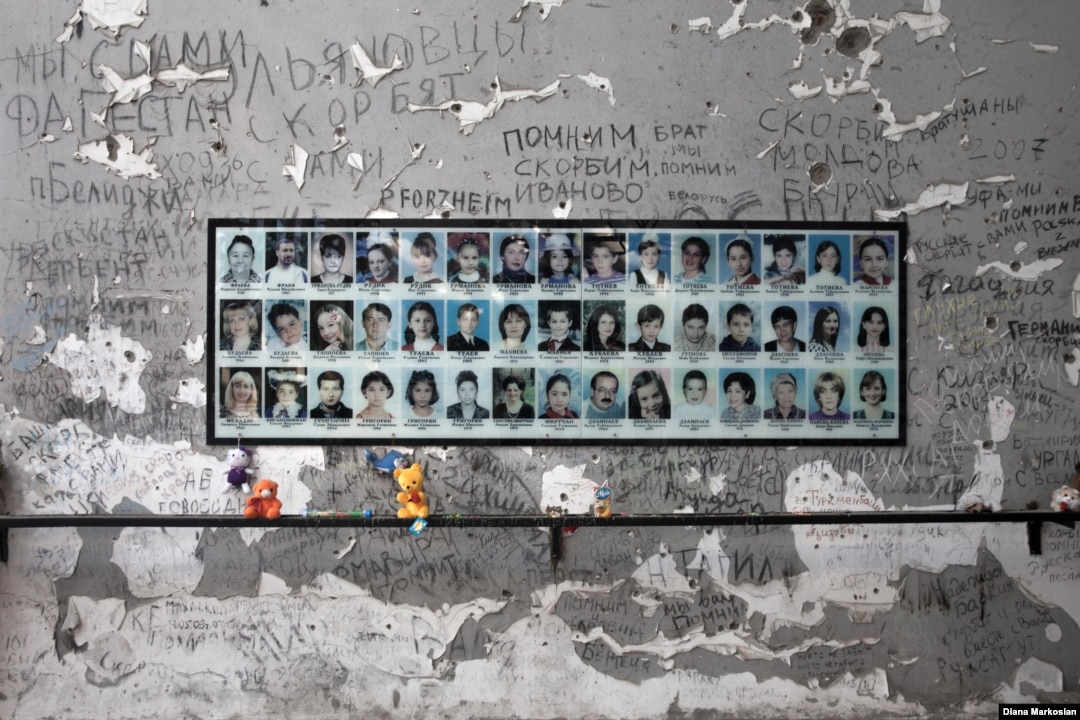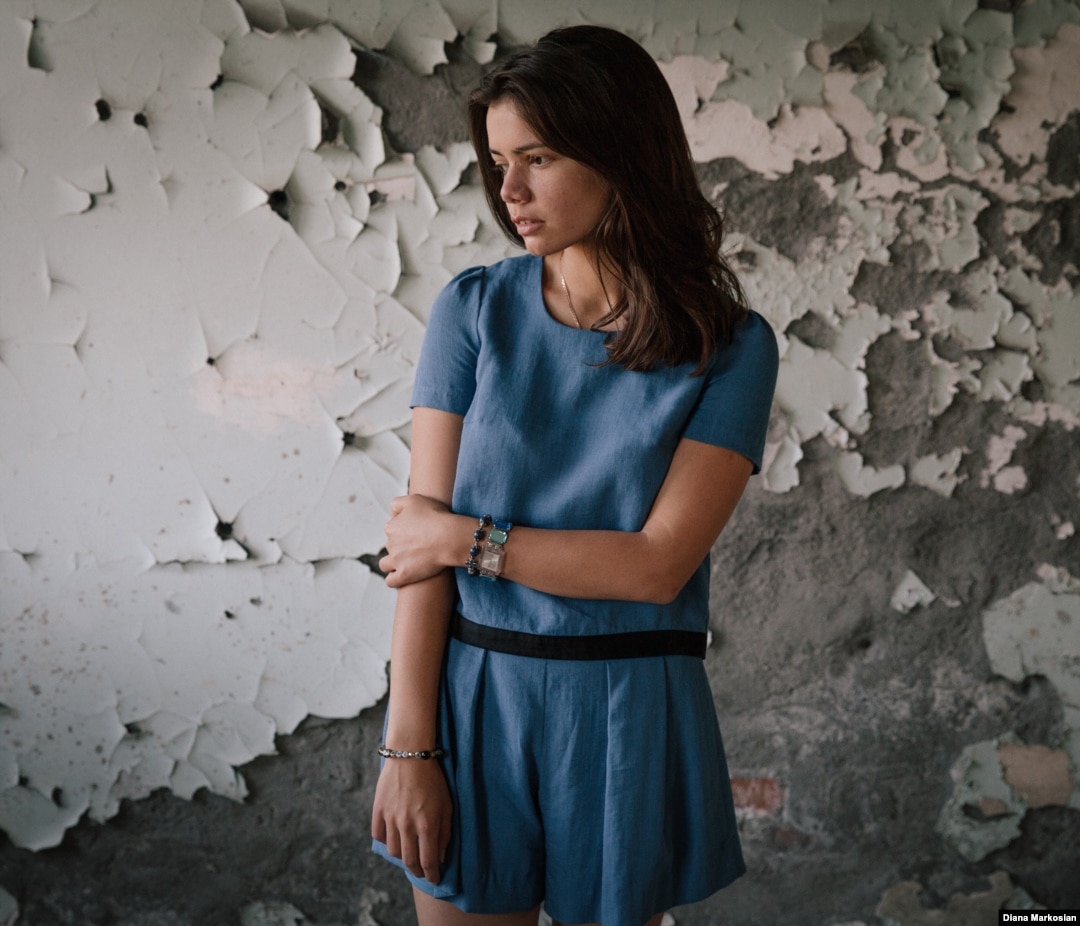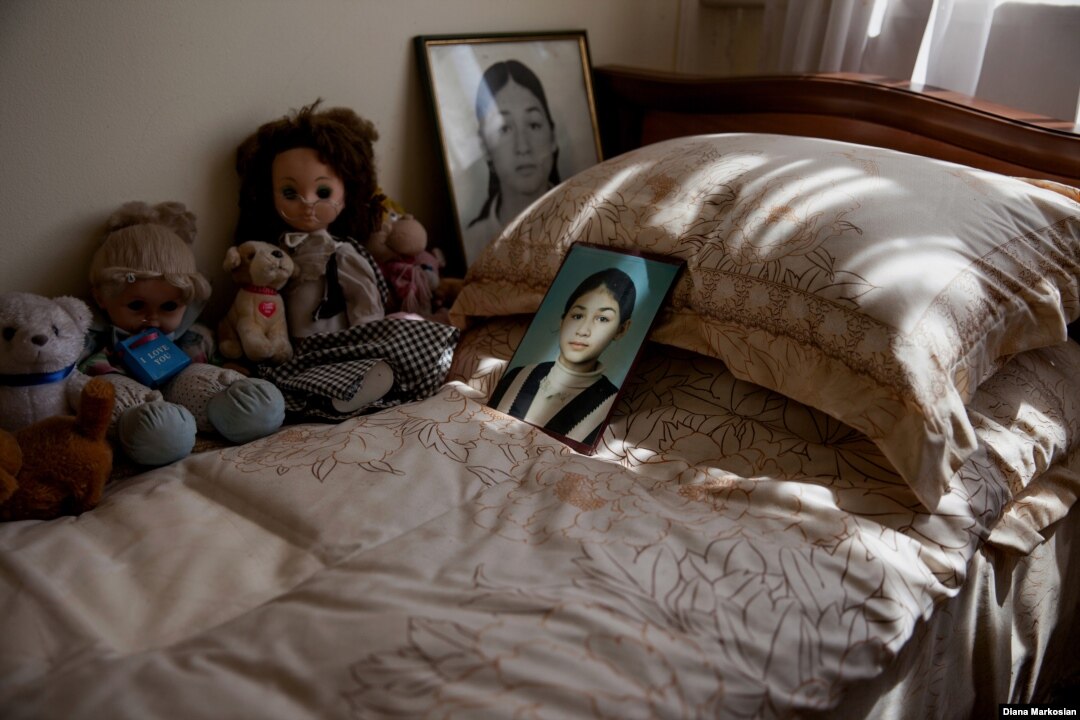Ten Years After Beslan, Memories Still Fresh

At School No. 1, portraits of more than 300 victims hang in the gymnasium where 1,100 children, parents, and teachers were held hostage for 52 hours. The school stands in ruins, and the room itself has been largely untouched since 2004. Bullet holes and haunting inscriptions of "we remember" adorn the walls; there is a charred gym ladder to one side and blackened basketball hoops at either end. An Orthodox cross has been placed in the middle of the gym floor, surrounded by freshly opened bottles of water left to commemorate the captives, who endured over two days in fierce summer heat with almost no water. Residents continue to bring teddy bears, model cars, and other toys in memory of the 186 children who were killed here.

Amina Kachmazova stands in the cafeteria of School No. 1. She was just shy of her 8th birthday when she went to school on September 1, 2004. She walked there with two teenage neighbors, Lyalya and Alina. When the hostages were forced into the gymnasium, she had no relatives with her. She remembers the militants executing a man at the front of the hall to warn everyone to be quiet. Before those days, Amina had never heard of an "explosion." But by the end, she had lost an eye in the blasts that rocked through the room on the third day. Lyalya and Alina were killed. Ten years later, Amina is studying international relations at a university in Vladikavkaz. She laughs easily; she says she loves life.

Time has stood still in Oksana Kokova's bedroom. Her father, Ruslan, likes to keep her door open. Oksana managed to escape after the explosions on the third day, but she returned to the school to help the younger children flee. She was killed in the process. Oksana was talented at sports, and loved karate and knitting. Living alone with her father and older brother, she had become accustomed to taking care of the house. She was friendly and talkative; she liked to take charge. Oksana was 15 years old.
"I feel like she is still with us," says Ruslan Kokov, 63. Ruslan was at the market when Oksana walked across the road to school, never to return. On her birthday, Ruslan and his son, Uruzmag, 27, always lay a place for her at dinner. They eat the foods she liked: melon, persimmons, blood oranges. Ruslan is pictured here standing in front of his house on Komintern Street. School No. 1 is clearly visible from his front room. Russian special forces were staked out there during the siege; during the final gun battle, bullets shattered his two front window panes. Ten years later, Ruslan hasn't gotten around to fixing them. "When I come across something that reminds me of the tragedy, it just upsets me unnecessarily," he says.
Nadezhda Guriyeva, 54, a history teacher, stands in the classroom at School No. 1 where she taught for more than 20 years. The curtains she put up with her son, Boris, still hang in the windows. Nadezhda -- or Nadya, as she prefers -- was taken hostage with her three children. Boris and her older daughter, Vera, died and their bodies burned in a fire sparked by explosives on the last day of the siege. They were 14 and 11. Boris and Vera had been scheduled to perform a dance at the school to mark the first day back. Vera's body was identified by the dress she had worn specially for the dance. Nadya and her youngest daughter escaped. Nadya now teaches in a new school built across from School No. 1.
Azamat Dzebisov's cousin, Zaur, was like a brother -- the "closest person" in the world to him. They were raised together in the same house, separated by only a year. On the first day of school, they were taken hostage together, along with Azamat's mother, Svetlana. During the course of the three-day siege, the cousins were split up. Zaur's burned body was later found in the school gymnasium. Azamat, 20, now studies in Moscow, but still spends his vacations in Beslan. Standing in his old classroom, he remembers a series of dreams he had about Zaur in the weeks after his death. "In the very last dream, he was parting with me and calling for me to come with him. I told him no, I have things left to do here. He smiled and told me good-bye."
Lena Gaitova (left) and sisters Zarina (center) and Rozita Tsirikhova were 12, 14, and 10... on September 1, 2004. The girls escaped at the end of the siege, but when Lena got home, she found her parents dressed in black and her 16-year-old brother, Alan, missing. First her parents said he was in the hospital. But soon they admitted he had died at the school. Today, the three girls remain best friends. All three study at the same institute in Moscow; Zarina has already graduated. They are pictured in the former library of School No. 1, where the militants stored their weapons. "It was easier before, when we were little and we didn't understand everything," says Lena. "We didn't understand what it meant when suddenly there were seven fewer of our friends in class. Now we're grown up. As time goes by, the pain doesn't go away. Quite the opposite, it gets harder. We are more aware."
Kristina Dzgoyeva was 11 when she went to the first day of school with her 10-year-old sister, Dzera, and their mother. They stayed close together in the gymnasium after they were taken hostage, but got separated from each other after the explosions on the third day. Kristina and her mother survived, but Dzera died at the school. The family had always lived next to the school, but after the attack, they moved several blocks away. Kristina, pictured here in her old classroom, keeps all of her memories about the siege written down in a diary. Ten years later, she is studying in Moscow and prefers to be far from Beslan. "I don't want anything back here," she says.
The grave of Kristina's sister, Dzera, stands with those of other Beslan victims in the cemetery that locals now call the "Little Town of Angels." The cemetery is almost never empty. For many survivors, it's become a place to seek calm and carry out symbolic rites of passage for the children who never lived to adulthood. This year, many parents adorned gravestones with graduation ribbons for children who would have finished high school in 2014. Kristina says she still goes to the cemetery during trips home to talk to Dzera; it makes her feel happy. Kristina's mother remains deeply scarred by the loss of her younger daughter. The inscription on Dzera's gravestone reads, "Forgive us that you're not here with us, and forgive me that I'm not there with you -- Mama."
In recent days, locals have cleared away a year's worth of toys from the gym in School No. 1 to make way for a wave of new offerings that people will bring to mark the 10-year anniversary of the siege. The three-day commemoration will begin September 1 with a now-traditional funeral service at the old school, followed by a procession to the cemetery. The gym itself is encased in a golden sarcophagus that, with its floral pattern, signifies a huge wreath. On the second day, there will be a requiem concert in Vladikavkaz, the regional capital of North Ossetia. On Wednesday, September 3, mourners will hold two final funeral services, and release white balloons to represent each of the lives lost.

